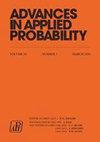Stochastic comparison on active redundancy allocation to k-out-of-n systems with statistically dependent component and redundancy lifetimes
IF 1.2
4区 数学
Q3 STATISTICS & PROBABILITY
引用次数: 2
Abstract
In the literature on active redundancy allocation, the redundancy lifetimes are usually postulated to be independent of the component lifetimes for the sake of technical convenience. However, this unrealistic assumption leads to a risk of inaccurately evaluating system reliability, because it overlooks the statistical dependence of lifetimes due to common stresses. In this study, for k-out-of-n:F systems with component and redundancy lifetimes linked by the Archimedean copula, we show that (i) allocating more homogeneous redundancies to the less reliable components tends to produce a redundant system with stochastically larger lifetime, (ii) the reliability of the redundant system can be uniformly maximized through balancing the allocation of homogeneous redundancies in the context of homogeneous components, and (iii) allocating a more reliable matched redundancy to a less reliable component produces a more reliable system. These novel results on k-out-of-n:F systems in which component and redundancy lifetimes are statistically dependent are more applicable to the complicated engineering systems that arise in real practice. Some numerical examples are also presented to illustrate these findings.具有统计相关成分和冗余寿命的k / n系统主动冗余分配的随机比较
在有关主动冗余分配的文献中,为了技术上的方便,通常假定冗余生命周期与组件生命周期无关。然而,这种不切实际的假设导致了不准确评估系统可靠性的风险,因为它忽略了由于共同压力而导致的寿命的统计依赖性。在本研究中,对于由阿基米德copula连接的组件和冗余寿命的k- of-n:F系统,我们表明(i)向可靠性较低的组件分配更多的齐次冗余往往会产生具有随机较大寿命的冗余系统;(ii)在齐次组件的情况下,通过平衡齐次冗余的分配,可以均匀地最大化冗余系统的可靠性。(iii)将更可靠的匹配冗余分配给不太可靠的组件,从而产生更可靠的系统。这些关于k- of-n:F系统的新结果更适用于实际应用中出现的复杂工程系统,其中组件和冗余寿命是统计相关的。文中还给出了一些数值例子来说明这些发现。
本文章由计算机程序翻译,如有差异,请以英文原文为准。
求助全文
约1分钟内获得全文
求助全文
来源期刊

Advances in Applied Probability
数学-统计学与概率论
CiteScore
2.00
自引率
0.00%
发文量
64
审稿时长
6-12 weeks
期刊介绍:
The Advances in Applied Probability has been published by the Applied Probability Trust for over four decades, and is a companion publication to the Journal of Applied Probability. It contains mathematical and scientific papers of interest to applied probabilists, with emphasis on applications in a broad spectrum of disciplines, including the biosciences, operations research, telecommunications, computer science, engineering, epidemiology, financial mathematics, the physical and social sciences, and any field where stochastic modeling is used.
A submission to Applied Probability represents a submission that may, at the Editor-in-Chief’s discretion, appear in either the Journal of Applied Probability or the Advances in Applied Probability. Typically, shorter papers appear in the Journal, with longer contributions appearing in the Advances.
 求助内容:
求助内容: 应助结果提醒方式:
应助结果提醒方式:


